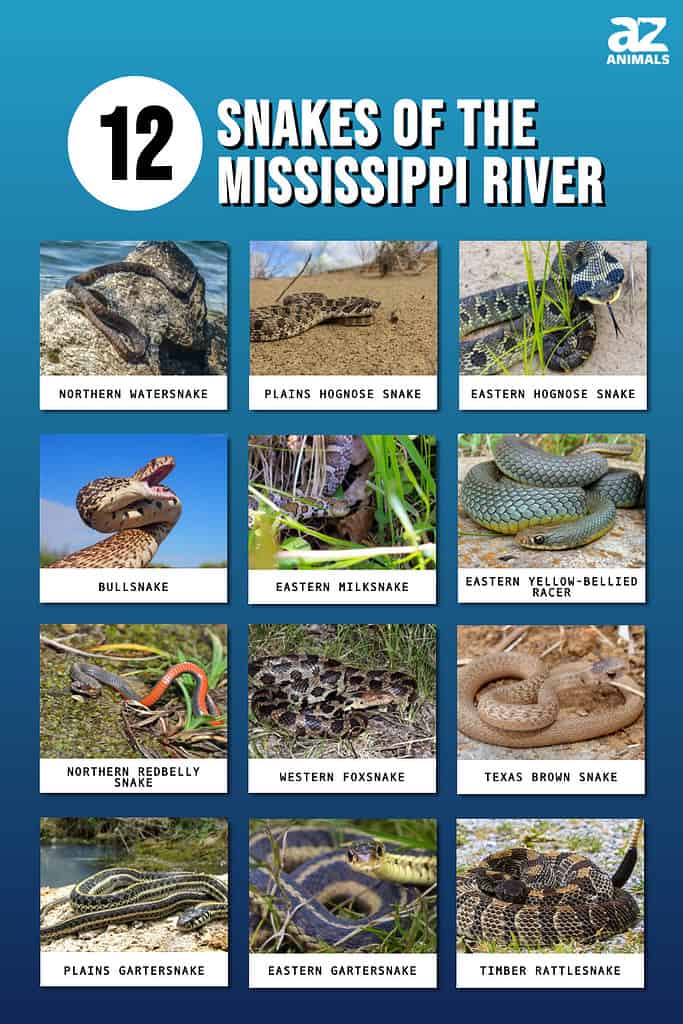

The Mississippi River runs from Minnesota down the center of the country, 2,350 miles, to Louisiana where it pours into the Gulf of Mexico. It is a major commercial waterway for people and home to many species of wildlife that live in and around the river habitat. Fish are plentiful, like largemouth bass, walleye, and catfish (big ones!), and so are waterfowl like wood ducks, Canadian geese, and Sandhill cranes. What about snakes? What kind of snakes make their home around the Mississippi River?
There is one species that spends most of its time in the river, another species that plays dead when threatened and, yes, there are venomous snakes that live around the Mississippi. Let’s meet 12 snakes of the Mississippi River!
1)Northern Watersnake

You can find Northern watersnakes sunning themselves on rocks next to the Mississippi River.
©jmarino/Shutterstock.com
The Northern watersnake is one of the snakes that live in the Mississippi River. It can be found swimming along the shoreline and slithering through the brush along the river. They are a thick-bodied non-venomous snake, about 2-3 feet long. They are a variety of colors but the most common ones have a dark brown or gray base color with small thin reddish-brown bands. Their bellies are lighter in color. Northern watersnakes can use their long bodies to circle around small fish and tadpoles in the Mississippi and then eat them all in one bite.
2) Plains Hognose Snake (Western Hognose Snake)

Plains hognose (Western hognose) snakes have a turned-up nose used for digging and burrowing.
©Amanda Guercio/Shutterstock.com
The plains hognose snake is a unique snake of the Mississippi River area that plays dead when threatened. They actually have a dramatic series of cards to play if they feel threatened. First, they will rise up and act tough, hissing and lurching, if that doesn’t work, they will literally play dead! They lie on their backs with their black belly exposed, throw their head back and even let their tongue dangle out the side of their mouth! Very dramatic. These are nonvenomous snakes that can get to be 1-3 feet long and have a base color of tan with distinct dark brown blotches along the back. They get their name from the turned-up nose that they use for digging in the soil along the Mississippi River banks.
3) Eastern Hognose Snake
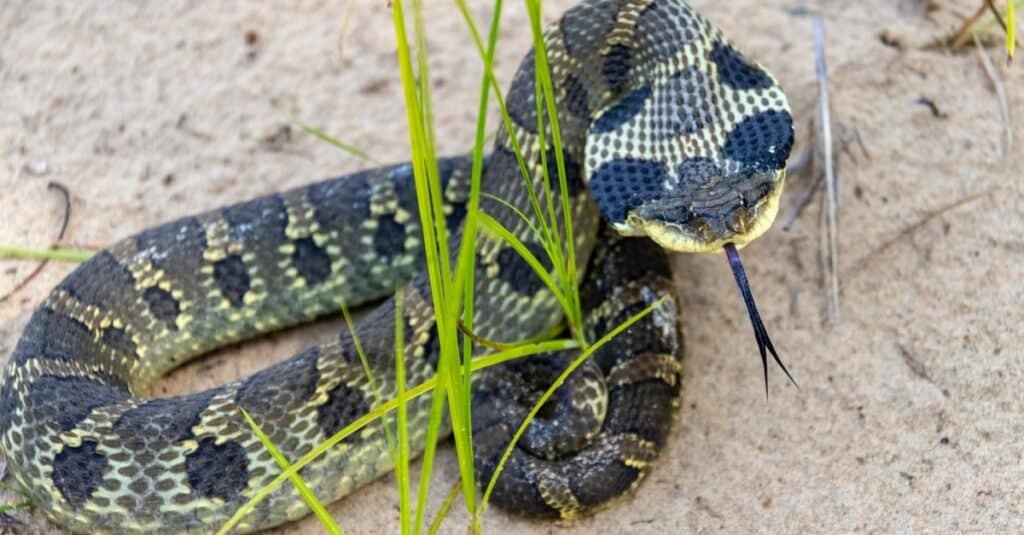
The eastern hognose snake will flatten its head and neck to make it look like a cobra!
©IHX/Shutterstock.com
The eastern hognose is similar to the western hognose with a slightly different range. These snakes are also known as “puff adders” because they can puff out their head and neck to make them look like they have the collar of a cobra! If their impressive cobra impression is not threatening enough they will try the “play dead” strategy like the western hognose. These heavy-bodied snakes are about the same size as the western hognose, 1-3 feet long. The eastern hognose has a larger range, found in the eastern half of the United States, including along the Mississippi River.
4) Bullsnake

When threatened, the Bullsnake rears up in an S-shape, hisses, and shakes its tail to look like a venomous rattlesnake.
©Markparker1983/Shutterstock.com
The bullsnake is a thick-bodied, long snake that can get to be 8 feet long. They have a base color that is cream colored with dark brown markings along its back. West of the Mississippi, these snakes are sometimes called gopher snakes. Bull snakes have some acting skills as well and will pretend to be rattlesnakes! They will coil their body, puff out their head to make it look triangular, and rattle their tail against loose rocks or dirt to make a noise like a rattle. Their bites will hurt, but they are not venomous.
5) Eastern Milksnake

Harmless and small, the Eastern milksnake looks similar to a variety of other potentially dangerous snakes on the Mississippi River.
©iStock.com/mynewturtle
Eastern milksnakes are 2-3 feet long and a thinner snake around the size of a garden hose. They have unique patterned scales in shades of tan, gray, black, and orange or red, and prefer to be left alone. While they are not particularly dangerous, they can appear similar to a variety of other potentially venomous snakes.
6) Eastern Yellow-bellied Racer
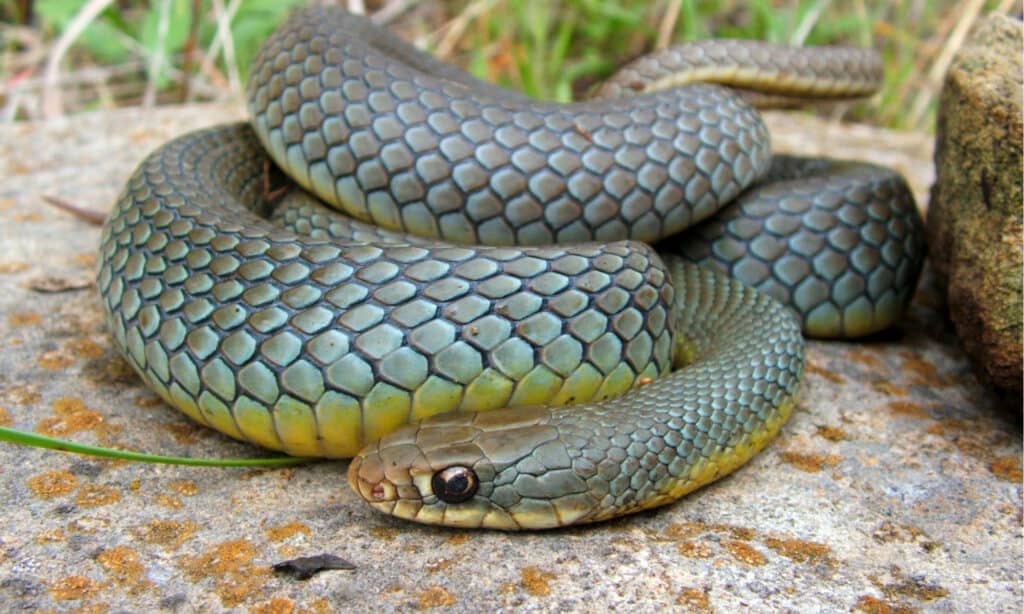
Although they are called Eastern yellow-bellied racers they are found west of the Mississippi River, mostly in Missouri with the River being the eastern edge of their range.
©Matt Jeppson/Shutterstock.com
Eastern yellow-bellied racers do not try to act or look like other snakes. If they are threatened they run (technically they slither)! These thin snakes are fast, like other racer snakes. Although they are called Eastern yellow-bellied racers they are found west of the Mississippi River, mostly in Missouri with the River being the eastern edge of their range. Western yellow-bellied racers live along the coast of California, up to Canada, and as far east as the edge of Montana and Wyoming. These snakes are all one color usually, olive green to gray with a…you guessed it…yellow belly. They are a thinner snake that grows to 2 ½ – 4 feet.
7) Northern Redbelly Snake
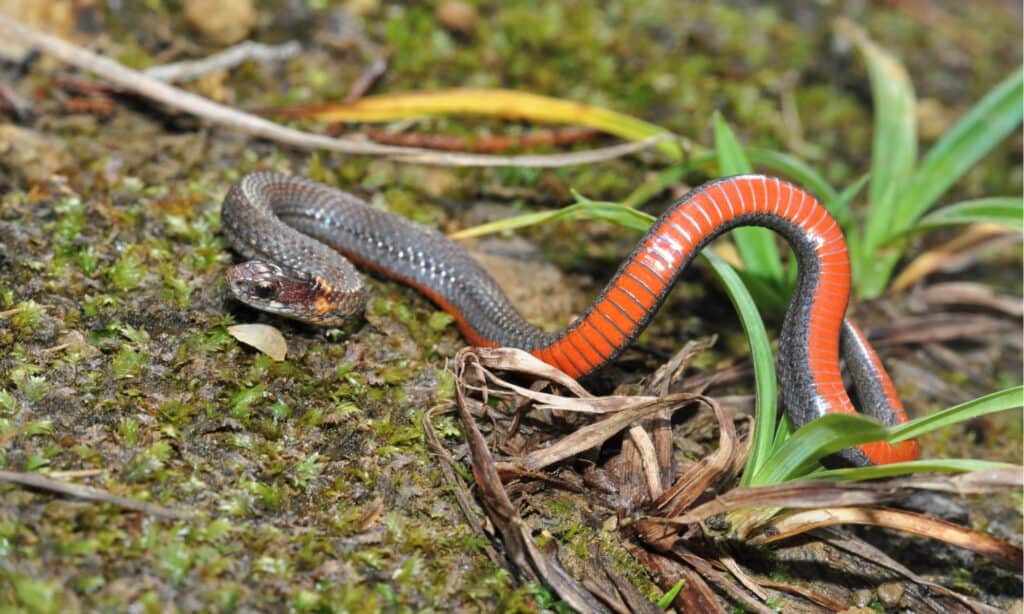
Northern Redbelly snakes that live along the banks of the Mississippi are only 8-10 inches long!
©Mike Wilhelm/Shutterstock.com
Let’s get the easy stuff out of the way first, yes, these snakes do have a red belly. Their base color is a uniform reddish brown with three dots behind the head. You will not get this snake mixed up with the Red-Bellied Black Snake because of the obvious size difference (and the fact that they are only found in Australia). Northern Redbelly snakes that live along the banks of the Mississippi are only 8-10 inches long! These little snakes feed on insects, earthworms, and slugs.
8) Western Foxsnake
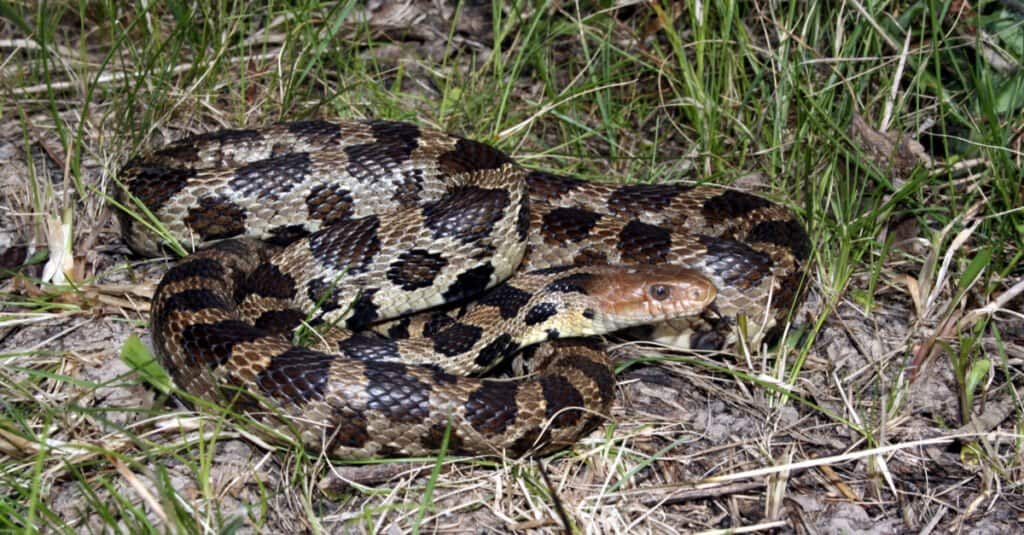
The western foxsnake can reach 5 feet in length along the Mississippi River. They can emit a smelly odor that smells like a red fox.
©Psychotic Nature/Shutterstock.com
The western foxsnake doesn’t try to act like other snakes, but it does smell like another animal. It got its name because if it feels threatened or is handled it will release a foul smell that smells like a red fox. They are thick-bodied snakes that can reach 5 feet long. Their base color is tan to light brown and they have distinct dark brown blotches all the way down their back. The head of the western foxsnake is all bronze in color.
9) Texas Brown Snake
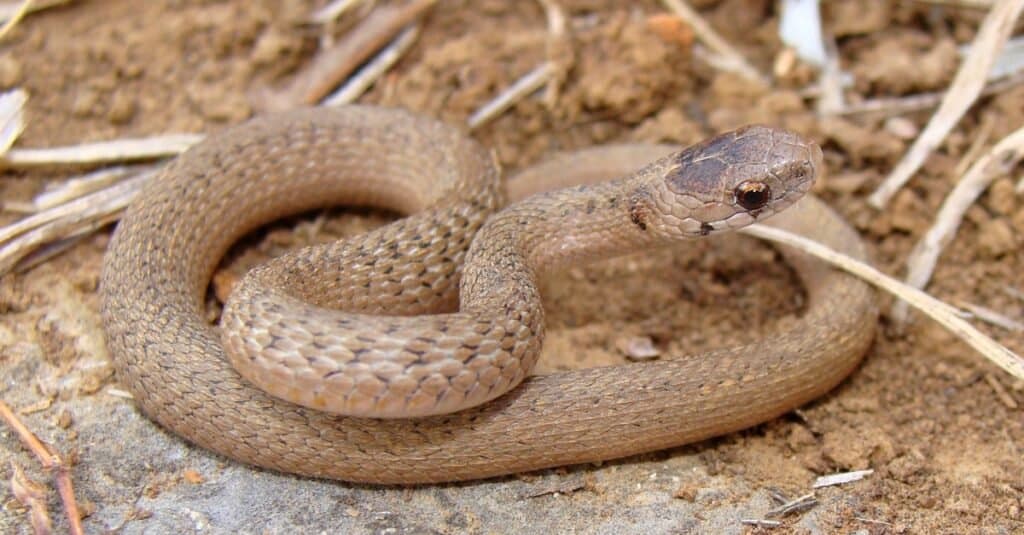
While Texas likes to boast about being the biggest state (in the lower 48) it can’t boast about the size of the Texas Brown Snake.
©Matt Jeppson/Shutterstock.com
The state of Texas does not border the Mississippi River, but the range of the Texas Brown Snake extends east of Texas across the River. While Texas likes to boast about being the biggest state (in the lower 48) it can’t boast about the size of this Dekay’s brownsnake subspecies. These little snakes don’t get much bigger than 1 foot long and are skinny too. They are all brown, with some being tan or reddish. However, their mouths are not big enough to bite humans.
10) Plains Gartersnake
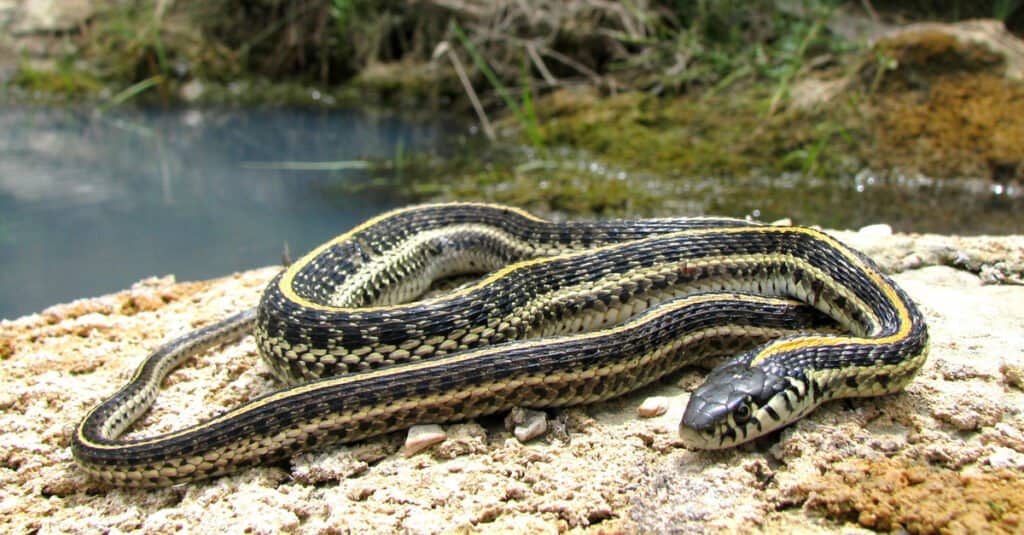
Plains gartersnakes have a long yellow stripe that goes down the length of their back.
©Joe Farah/Shutterstock.com
The Mississippi River cuts through the Great Plains of the US with much of the land surrounding the river used as farmland. The plains gartersnake prefers wet meadows and marshes along the River. They have a base color of olive green with a bright yellow stripe that goes down their back. Plains garter snakes are about 1-2 feet long and of medium thickness. If they are threatened they don’t show it, and they are less likely to bite even when handled. If they did get annoyed and bite, they are not poisonous.
11) Eastern Gartersnake
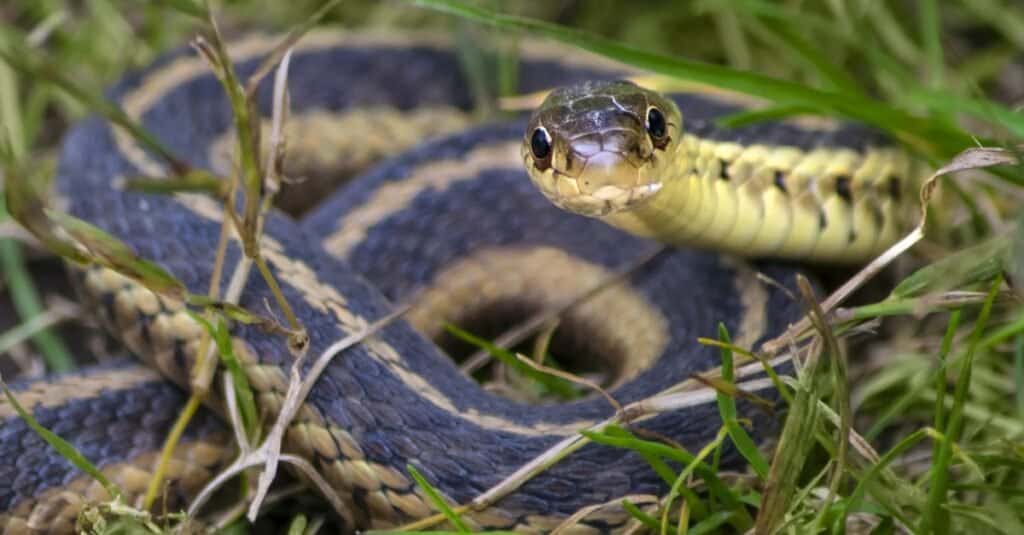
Eastern gartersnakes are a little longer than plains gartersnakes.
©K Quinn Ferris/Shutterstock.com
Eastern gartersnakes look very similar to plains gartersnakes with the difference being where their stripes are located. Snakes have rows of scales. Garter snakes have stripes that go all the way down the back and sides. Eastern gartersnakes have their lower stripes closer to the ground. They are also a little longer and skinnier than plains gartersnakes and have a white jawline.
12) Timber Rattlesnake

Timber Rattlesnakes are the most dangerous of the snakes of the Mississippi River. They are venomous and harmful to humans.
©Frode Jacobsen/Shutterstock.com
Now for the most dangerous snake on our list, the Timber Rattlesnake is poisonous! It has fangs that produce venom (so it is technically venomous) that is harmful to humans. Sometimes called a canebrake, they are heavy-bodied snakes and the largest venomous snake in many states. They are not as big as the eastern diamondback which is the largest venomous snake in America (some being 6 feet long and weighing 15 lbs).
Timber rattlesnakes grow to be 3-5 feet long and have a tan base color with dark brown blotches. As pit vipers, they have two small holes (pits) on the side of their head which are used as a sensing tool. They have a triangular head and a rattle at the end of the tail. If threatened they will coil their body, raise the front of their body, rattle their tail, and flip down their fangs (they can fold up for “storage”). Although you won’t find Timber Rattlesnakes at the headwaters of the Mississippi River. They don’t live quite that far north, they live in southern Minnesota, along the Mississippi down to the Gulf.
This is not an exhaustive list of all the snakes that inhabit the Mississippi River region. In fact, there are a total of 6 venomous snakes, only one of which we have covered (the timber rattlesnake). Others include cottonmouth (water moccasin), copperhead, coral snake, pygmy rattlesnake, and eastern diamondback rattlesnake. Of these, the cottonmouth is the only venomous water snake, not only on the Mississippi River but actually in all of North America.
What Other Animals Live Along the Mississippi River?
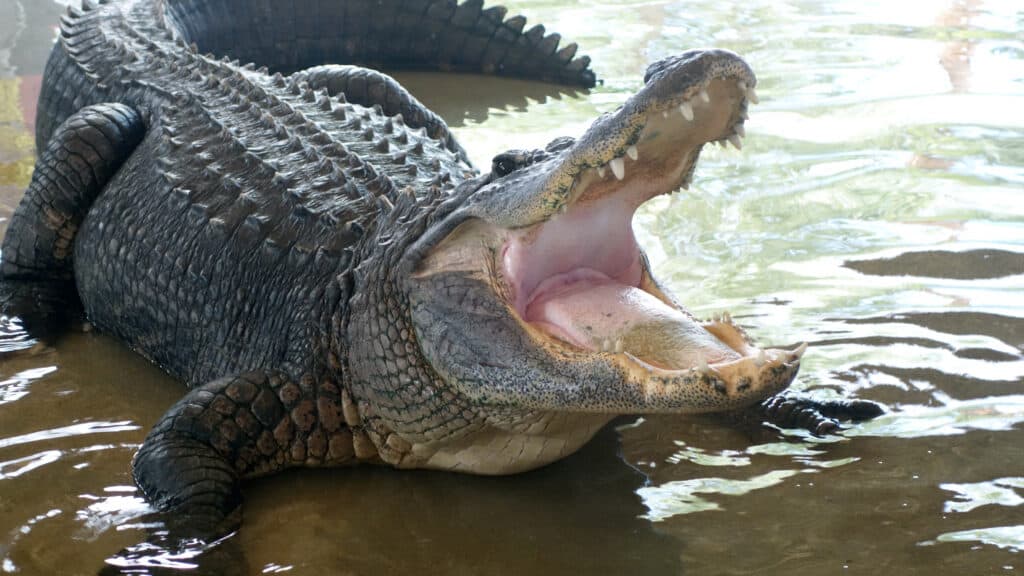
American alligators can be found lurking in swamps close to the Mississippi River
©Ernie Hounshell/Shutterstock.com
Snakes are by no means the only creatures that enjoy living in the Mississippi River’s environs.
Several other animals, birds, mammals, and reptiles included, also call the area home.
They include bull sharks making their way inland all the way from the Gulf of Mexico, American alligators lounging in nearby swamps, beavers that are capable of cutting up to a ton of wood per year, and North American river otters that are thriving once more in spite of nearly being hunted to extinction.
Other denizens include bald eagles, black bears, coyotes, deer, muskrats, peregrine falcons, and spotted sandpipers.
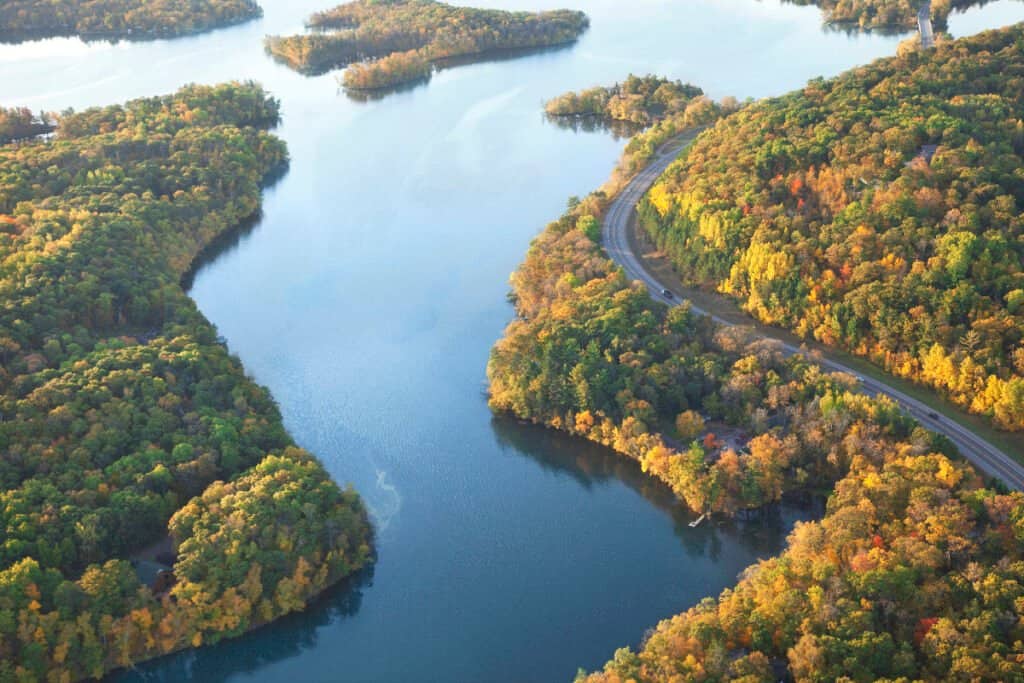
The Mississippi River is 2,350 miles long from Minnesota down to the Gulf of Mexico, and there are a number of snakes that live along it.
©iStock.com/Willard
Summary of 12 Snakes of the Mississippi River
Let’s round up the 12 snakes who make their homes on the Mississippi River:
| Rank | Snake |
|---|---|
| 1 | Northern Watersnake |
| 2 | Plains Hognose Snake |
| 3 | Eastern Hognose Snake |
| 4 | Bullsnake |
| 5 | Eastern Milksnake |
| 6 | Eastern Yellow-bellied Racer |
| 7 | Northern Redbelly Snake |
| 8 | Western Foxsnake |
| 9 | Texas Brown Snake |
| 10 | Plains Gartersnake |
| 11 | Eastern Gartersnake |
| 12 | Timber Rattlesnake |
The photo featured at the top of this post is © Matt Jeppson/Shutterstock.com
Discover the "Monster" Snake 5X Bigger than an Anaconda
Every day A-Z Animals sends out some of the most incredible facts in the world from our free newsletter. Want to discover the 10 most beautiful snakes in the world, a "snake island" where you're never more than 3 feet from danger, or a "monster" snake 5X larger than an anaconda? Then sign up right now and you'll start receiving our daily newsletter absolutely free.
Thank you for reading! Have some feedback for us? Contact the AZ Animals editorial team.






